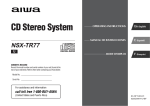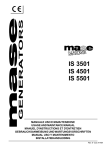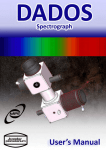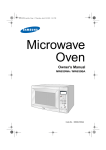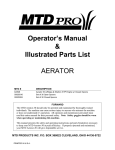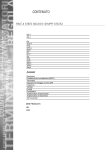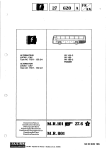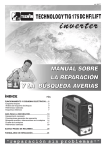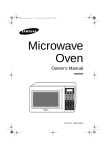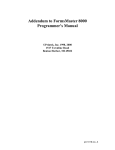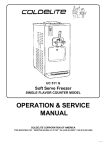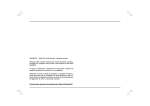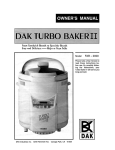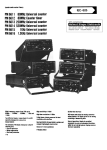Download FM 2500 M 4000 M 5600 M 6000 T 8000 M
Transcript
FM 2500 M 4000 M 5600 M 6000 T 8000 M MANUALE USO E MANUTENZIONE USAGE AND MAINTANCE MANUAL MANUEL D'INSTRUCTIONS ET D'ENTRETIEN cod 40928 MASE FM 1 2 MASE FM 2 3 MASE FM 3 4 4 MASE FM FM2500 FM 8000 6 5 5 MASE FM FM 2500 FM 4000 6 MASE FM FM 5600 12 3 5 6 11 7 8 1 1 10 9 1 4 FM 6000 9 10 4 6 1 5 2 7 ECC A.V.R. 3 7 1 8 3 MASE FM FM 8000 8 MASE I FM INDICE 1) NORME DI SICUREZZA 2) CARATTERISTICHE TECNICHE DIMENSIONI E PESO 3) COMPOSIZIONE DEL GRUPPO 4) INSTALLAZIONE E CONTROLLI PRELIMINARI 4.1) Posizionamento del gruppo 4.2) Controlli preliminari 4.3) Combustibile 5) UTILIZZO DEL GRUPPO 5.1) Avviamento 5.2) Impiego del gruppo 5.3) Protezioni e segnalazioni 5.4) Arresto del gruppo 6) MANUTENZIONE 7) SCHEMI ELETTRICI PERICOLO Indica che è necessario prestare attenzione al fine di non incorrere in serie conseguenze che potrebbero provocare la morte del personale o possibili danni alla salute. Situazione che potrebbe verificarsi durante il periodo di vita di un prodotto, sistema o impianto considerato a rischio in materia di danni alle persone, alle proprietà, all’ambiente o di perdite economiche. ATTENZIONE CAUTELA Indica che è necessario prestare attenzione al fine di non incorrere in serie conseguenze che potrebbero portare al danneggiamento di beni materiali quali le risorse o il prodotto INFORMAZIONI Indicazioni di particolare importanza. I disegni sono forniti a scopo esemplificativo. Anche se la macchina in vostro possesso si differenzia sensibilmente dalle illustrazioni contenute in questo manuale la sicurezza e le informazioni sulla stessa sono garantite. Il costruttore, nel perseguire una politica di costante sviluppo ed aggiornamento del prodotto, può apportare modifiche senza preavviso. 9 MASE FM I 2) CARATTERISTICHE TECNICHE GRAZIE PER AVERE SCELTO UN PRODOTTO MASE. Il presente libretto contiene le più importanti informazioni per un corretto uso del generatore. Per la sicurezza e soddisfazione del Cliente e per l’ affidabilità del gruppo elettrogeno sono essenziali una corretta installazione e verifica prima della consegna. Un controllo non accurato o un errore di montaggio possono compromettere l’ efficienza del generatore e pregiudicare la sicurezza dell’ utente. Tutte le informazioni e illustrazioni di questo manuale si riferiscono al modello esistente al momento della pubblicazione. Per eventuali ulteriori informazioni La preghiamo di rivolgersi al più vicino centro di assistenza MASE che sarà lieto di assisterla. La MASE si riserva il diritto di apportare modifiche senza darne alcun preavviso. Nessuna parte o illustrazione di questo manuale può essere riportata senza autorizzazione. GENERATORE 2500 M 4000 M 5600 M 6000 T 8000 M MOTORE Brigss & Stratton Brigss & Stratton Brigss & Stratton Brigss & Stratton Brigss & Stratton TIPO 132232 195432 254422 254422 303400 1 1 1 1 2 c.c 206 319 400 400 480 POTENZA Hp (Na) 3.2 5.1 7.5 7.5 10.4 CONSUMO 1.6 1.7 3 3 4 3 12 12 12 9 3000 3000 3000 3000 3000 POT. CONT. (380 V) - - - 5000 - POT. CONT. (220 V) 1800 3000 4400 3000 6300 Nr. CILINDRI CILINDRATA Lt/h CAPAC. SERB. Lt GIRI /1' MASE GENERATORS S.p.A. 1) NORME DI SICUREZZA 3) COMPOSIZIONE DEI GRUPPI - Leggere attentamente tutte le informazioni contenute in questo opuscolo: esse sono fondamentali per una corretta installazione ed utilizzo del gruppo e per essere in grado di intervenire tempestivamente in caso di necessità. - Non consentire l’ uso del gruppo a persone non competenti o che non siano state istruite adeguatamente. - Non consentire a bambini od animali di avvicinarsi al gruppo elettrogeno in funzione. - Non accedere al generatore o al cruscotto di comando a distanza con mani bagnate essendo il generatore una potenziale fonte di shock se male utilizzato. - I gas di scarico contengono monossido di carbonio ed altri residui nocivi all’ organismo: è importante non fare mai funzionare il gruppo in ambienti chiusi. - Non far funzionare il gruppo in vicinanza di luoghi con pericolo di esplosione o di incendio. - Eventuali controlli sul gruppo elettrogeno vanno eseguiti a motore spento; controlli sul gruppo in funzione vanno effettuati solo da personale specializzato. - Il rifornimento di carburante va eseguito a motore spento. - Il collegamento a terra del gruppo va fatto con cavo di rame di sezione non inferiore a 6 mmq. I gruppi della serie FORMULA sono generatori sincroni di c.a. monofase e/o trifase composti essenzialmente da: - Un telaio portante (Fig.1 Rif.1). - Un alternatore sincrono autoeccitato ed autoregolato (Fig. 1 Rif.2). - Un motore (Fig.1 Rif.3) 4 tempi a benzina. - Un cruscotto comandi (Fig.1 Rif.4) composto da: 1) Termico generale 2) Presa 2P+T 3) Interruttore generale 4) Spia funzionamento 5) Interruttore Stop 6) Morsetto C.C. 24V 7) Morsetto C.C. 12V 8) Morsetto C.C. (-) 9) Fusibile circuito C.C. 10) Contaore 11) Presa 3P+T 12) Termico 3 ~ 13) Termico parziale 1~ ATTENZIONE Nell’ utilizzo del generatore occorre tener presente che nei luoghi bagnanti o molto umidi e nei luoghi conduttori ristretti esiste l’ obbligo del rispetto degli articoli 313 e 318 del D.P.R. 27/04/55 nr. 547, nonché del Cap. 11, Sez. IV della norma C.E.I. 64-8. 10 MASE FM I 4) INSTALLAZIONE E CONTROLLI PRELIMINARI 5.3) Protezioni e segnalazioni 4.1) Posizionamento del gruppo Il gruppo è dotato di alcune protezioni e segnalazioni che lo salvaguardano da un anomalo funzionamento e scorretto utilizzo; essi sono : - PROTEZIONE CIRCUITO c.a. il microdisgiuntore termico automatico (Fig.2 Rif.1-13) interviene interrompendo l’ erogazione di potenza alle prese c.a. in caso di sovraccarico o corto circuito. L’ intervento della protezione è visualizzato dal contemporaneo spegnimento della lampada spia verde (Fig.2 Rif.4) o dal non funzionamento del contaore (Fig.2 Rif.10) sull’ FM 8000 e dall’ intervento del termico (Fig.2 Rif.1-12-13). Per il riarmo è sufficiente, dopo aver individuato ed eliminato la causa dell’intervento, attendere circa un minuto e ripristinare il termico riportandolo nella posizione originaria. - PROTEZIONE USCITA c.c. (solo FM8000) fusibile 10A (Fig.2 Rif.9). - PROTEZIONE MANCANZA OLIO: questa protezione spegne automaticamente il motore quando il livello dell’ olio scende sotto il livello minimo. L’ intervento di tale sistema di protezione è segnalato da una lampada rossa posta sul motore (Fig.5 Rif.1). Sul modello FM 8000 non c’è alcuna lampada. I gruppi vanno posizionati orizzontalmente, accertandosi che lo scarico non sia diretto contro nessun ostacolo o sia posizionato ad almeno 2mt. da esso. Effettuare inoltre il collegamento a terra con un cavo di sezione non inferiore a 6 mmq. servendosi dell’ apposito morsetto (Fig.3). 4.2) Controlli preliminari Prima di ogni avviamento è bene controllare sempre: - Il livello dell’ olio ed il livello del carburante nel serbatoio. - Che il gruppo sia bene in equilibrio sui suoi punti di appoggio. - Che non vi siano utenze elettriche inserite. - Che i necessari collegamenti siano eseguiti correttamente e non vi siano connessioni elettriche in cattivo stato. 4.3) Combustibile Il rifornimento si effettua tramite il tappo usando preferibilmente benzina normale NOR 84-86. 5.4) Arresto del gruppo Prima di procedere allo spegnimento, scollegare gli eventuali carichi applicati, chiudere il rubinetto del combustibile, fare girare a vuoto il gruppo per qualche decina di secondi. Per ottenere lo spegnimento del motore è necessario agire sull’interruttore posto sul pannello strumenti (Fig.2 Rif.5). 5) UTILIZZO DEL GRUPPO 5.1) Avviamento Aprire il rubinetto del combustibile (Fig.4 Rif.1), tirare la levetta dello starter (Fig.4 Rif.2) e posizionare l’ interruttore on-off (Fig.4 Rif.3) in posizione on; afferrare l’ impugnatura (Fig.4 Rif.4) e tirare dolcemente fino ad avvertire la massima resistenza alla trazione (ciò indica che il motore è in fase di compressione), tirare quindi con uno strappo deciso; ad avviamento avvenuto riportare la levetta dello starter nella posizione originaria. La presenza di tensione sull’ alternatore è segnalata dall’ accensione della lampada spia verde (Fig.2 Rif.4). Sull’ FM 8000 la presenza di tensione è segnalata dal funzionamento del contaore (Fig:2 Rif.10). Per avere tensione alle prese è necessario posizionare il commutatore (fig.2 Rif.3) in pos. 1. N.B. Per i gruppi FM2500-8000 il comando Stop è posto sul motore (Fig.6 Rif.1). 6) MANUTENZIONE PERICOLO Qualsiasi intervento di manutenzione al gruppo va effettuato a motore spento, dopo averlo lasciato raffreddare a sufficienza e va eseguito solo da personale autorizzato. 5.2) Impiego del gruppo Si raccomanda di seguire scrupolosamente le indicazioni riportate nel manuale fornito dal costruttore del motore, allegato ad ogni gruppo. Se si prevede che il gruppo resti inattivo per lunghi periodi si consiglia di: - Sostituire l’ olio motore - Smontare la candela e versare qualche goccia di olio lubrificante pulito nel cilindro, far fare qualche giro al motore per distribuire l’ olio, indi rimontare la candela. - Pulire gli elementi del filtro aria. - Svuotare il carburatore. Prima di inserire qualsiasi utenza, fare girare a vuoto il motore per qualche decina di secondi. Ogni gruppo è dotato di due prese: - entrambe monofase per i modelli 2500 - 4000 - 5600 8000 (Fig.2 Rif.2); - una monofase ed una trifase per : il modello 6000 (Fig.2 Rif.2-11). Le potenze disponibili alle prese sono quelle indicate nelle caratteristiche tecniche e riportate sul cruscotto di ogni gruppo. 11 MASE FM SCHEMI ELETTRICI FM 2500 FM 8000 1 2 3 4 5 6 7 8 9 1 2 3 4 5 6 7 8 9 10 11 Diodo 25A 800V Varistore Rotore Statore Condensatore Spia generatore Interruttore prese AC Interruttore termico Presa 2p + t 16A FM 4000 1 2 3 4 5 6 7 8 9 10 Diodo 25A 800V Varistore Rotore Statore Condensatore Spia generatore Interruttore prese AC Interruttore termico Presa 2p + t 16A Interruttore ON-OFF FM 5600 1 2 3 4 5 6 7 8 9 10 11 12 Diodo 25 A 800 V Varistore Rotore Condensatore Statore Spia generatore Interruttore prese Interruttore termico Interruttore termico Presa 2p+t 16A Presa 2p+t 32A Interruttore ON-OFF FM 6000 1 2 3 4 5 6 7 8 9 10 Rotore Statore Regolatore elettronico Interruttore prese A.C. Magnetotermico Interruttore termico Presa 2p+t 16A Presa 3p+t 16A Interruttore ON-OFF Spia generatore 12 Rotore Statore Ponte diodi 25 A 400V Contaore Fusubile 10A Interruttore termico Presa 2p+t 16A Condensatore Pulsante stop Diodo 20A 800V Varistore MASE GB FM CONTENTS 1) SAFETY REGULATIONS 2) TECHNICAL PARTICULARS DIMENSIONS AND WETGHT 3) UNIT COMPONENT-PARTS 4) INSTALLATION AND PRELIMINARY CHECKS 4.1) Unit location 4.2) Preliminary checks 4.3) Fuel 5) GENERATOR USE 5.1 ) Starting 5.2) Unit use 5.3) Safety devices 5.4) Generator stop 6) MAINTENANCE 7) WIRING DIAGRAM DANGER A statement advising of the need to take care lest there be serious consequences resulting in death of personnel or in hazard to health. A situation that could occur during the lifetime of a product, system or plant that has the potential for human injury, damage to property, damage to the environment, or economic loss. WARNING CAUTION A statement advising of the need to take care lest serious consequences result in harm to material items such as the asset or the product. INFORMATION Important information. Drawing are provided by way of example. Should your machine be quite different from the illustrations contained in this manual, the safety regulations and relevant information are always granted. The manufacturer's policy of constant development and updating may lead to modifications without prior notice. 13 MASE FM GB 2 TECHNICAL FEATURES CONGRATULATIONS ON HAVING CHOSEN A MASE PRODUCT This manual contains all the necessary information for proper installation and use of the generator. It’s essential, either for the customer’s safety and satisfaction or for good reliability of the generator, to carry out proper installation and a careful pre-delivery test. A wrong installation or an oversight on testing may compromise the efficiency of the generator and even jeopardize the customer’s safety. All information and illustrations in this handbook refer to the latest produced model at the time of printing. For any further information, please get in touch with the nearest MASE SERVICE CENTER, they’ll be pleased to help you at any time. MASE reserve the right to introduce changes without prior notice. No part or illustration contained in this handbook can be reproduced without previous approval by MASE GENERATOR 2500M 4000M 5600M ENGINE Brigss& Brigss& Brigss& Brigss& Brigss& Stratton Stratton Stratton Stratton Stratton TYPE 132232 195432 254422 254422 303400 Nr.CYLINDER 6000T 8000M 1 1 1 1 2 DISPLACEMENT c.c 206 319 400 400 480 POWER Hp(Na) 3.2 5.1 7.5 7.5 10.4 CONSUPTION Lt/h 1.6 1.7 3 3 4 TANKCAPACITY Lt 3 12 12 12 9 3000 3000 3000 3000 3000 CONT.POW.(380V) - - - 5000 - CONT.POW.(220V) 1800 3000 4400 3000 6300 RPM/1' MASE GENERATORS S.p.A. 1) SAFETY REGULATIONS 3) UNITCOMPONENT-PARTS - Read carefully all the instructions given in this handbook: they are of the utmost importance for correct istallation and use of the unit and for prompt intervention in case of need. - Do not allow unskilled or untrained peopie to use the unit. - Do not allow children or animals to get close to the generator while it’s working. - Do not handle the generator or the remote control panel with wet hands; any misuse may cause electric shocks. - Exhaust gas contains carbon monoxide and other residues which are injurious to health therefore it’s necessary not to make the generator work in closed areas. - Do not make the generator work near those areas where dangers of explosion or fire do exist. - Any testing of the unit is to be carried out only when the engine is stopped. Possible checks on the generator when it’s running have to be performed only by skilled workers. - Refuelling must be carried out only when the engine is stopped. - Earth-connection has to be made through copper cables having 6 sq.mms. cross-section at least. The gensets of the FORMULA series are singie-phase and/or three-phase A.C. synchronous generators essentially composed of: - a supporting frame (Fig. 1 Ref. 1). A self-excited and self-regulating synchronous alternator (Fig. 1 Ref. 2). - A four-stroke gasoline engine (Fig. 1 Ref. 3). - An instrument panel (Fig. 1 Rif. 1) with: 1 2 3 4 5 6 7 8 9 10 11 12 13 14 General thermal switch Single phase socket General switch Generator warning ligh Stop switch C.C. 24V terminal C.C. 12V terminal C.C. terminal (-) C.C. circuit fuse Hours meter Three phase socket 3 ~ thermal switch 1 ~ thermal switch MASE FM GB sockets are indicated in the specifications as well as on the instrument panel of each unit. 4) INSTALLATION ANDPRELIMINARY CHECKS 4.1) Positioning the unit 5.3) Safety devices Position the power unit horizontally and make sure that the gas exhaust is not turned towards any obstacle or that this is at least 2 m. away from the unit. Make the earth connection by means of the appropriate terminal and a wire having a section of not less than 6 sq.mm (Fig. 3). — Make sure that the fuel and the oil filler caps are well secured. The unit is equipped with a number of safety and warning devices which protect it from abnormal operation and improper use; These include: — A. C. ClRCUIT SAFETY DEVICE: the thermal circuit breaker (Fig. 2 Ref. 1-13) intervenes in case of overloading or shortcircuiting. The coming into operation of the circuit breaker is signalled by the turning off of the green pilot-light (Fig. 2 Ret. 4) as well as by not running of the hoursmeter (Fig. 2 Ref. 10) on FM 8000 and by the intervention of the thermic (Fig. 2 Ref. 1-1213). To reset the circuit breaker after having found and eliminated the source of trouble wait for about a minute, and bring the thermic back tooriginal position. — Make sure that the unit is at an equilibrium on its points of support. — D.C. OUTPUT PROTECTION DEVICE (only FM 800). Fuse 10 A (Fig. 2 Ref. 9). — Make sure that there are no electrical appliances connected. — OIL WARNING DEVICE: This device stops the unit while in operation or prevents it from starting, if the oil level is below minimum. The oil warning device will cause the red lamp (Fig. 5 Ref. 1) to flash. On FM 8000 model there is no lamp. 4.2) Preliminary checks Before start up and particulariy after every maintenance operations it is a good rule to: — Check the fuel and oil levels. 4.3) Fuel Unscrew the fuel filler cap and fill the tank prefarably with regular petrol NOR 84-86. 5.4) Turning off the unit Before turning off, disconnect any connected appliances, turn off the fuel tap7 let the motor run idle for a few tens of seconds, turn the switch (Fig. 2 Ref. 5) and release when the unit has actually stopped. 5) USE OF THE UNIT N.B. For FM 2500-8000 the stop device is on the engine (Fig. 6 Ref. 1). 5.1) start up Open the fuel tap (Fig. 4 Ref. 1), and pull the starting device lever (Fig. 4 Ref. 2); position the switch on-off (Fig.4 Ref. 3) in position “on”; grab the handle (Fig. 4 Ref. 4) and pull softly until you feel the highest tensile strength (this indicates that the motor is In compression). Then, give it a decisive tug. Once the power unit is started up, bring the starting device lever to the original position. The availability of tension at the sockets is signalled by the lighting of the green pilot-lamp (Fig. 2 Ref. 4) on the FM 8000 the presence of tension is signalled by the running of the hoursmeter (Fig. 2 Ref. 10). In order to have voltage at the sockets, it is necessary to position the commutator (Fig. 2 Ref. 3) in Pos. Nr. 1. 6) MAINTENANCE DANGER All maintenance work shall be carried out power-off by authorized personnel only after having let it cool down sufficiently. We recommend strictly keeping to the instructionss contained in the motor manufacturer7s manual supplied along with each unit. If you expect the unit to remain unused for long periods, we recommend the following: — Replace engine oil. — Take out the spark-plugs pour a few drops of lubricant oil into the cylinder, let the engine complete some revolutions so as to spread about the oil, then put the spark-plug back in place. —Clean the air filter elements. —Empty the carburettor. 5.2) Use of the unit Before connecting any appliances, let the motor run idie for a few tens of seconds. Each unit is equipped with two sockets: —both of the single-phase for the models 2500-4000-5600-8000 (Fig. 2 Ref. 2). — One single-phase and one three-phase for the model 6000 (Fig. 2 Ref. 2-11). The voltages available at the 15 MASE FM WIRING DIAGRAM FM 2500 M FM 8000 M 1 2 3 4 5 6 7 8 9 1 2 3 4 5 6 7 8 9 10 11 Diode 25 A 800 V Varistor Rotor Capacitor Stator Generator warning light A.C. socket switch Thermal Switch Socket 16A FM 4000 M 1 2 3 4 5 6 7 8 9 10 Diode 25 A 800 V Varistor Rotor Capacitor Stator Generator warning light A.C. socket switch Thermal Switch Socket 16A ON-OFF switch FM 5600 M 1 2 3 4 5 6 7 8 9 10 11 12 Diode 25 A 800 V Varistor Rotor Capacitor Stator Generator warning light A.C. socket switch Thermal Switch Thermal Switch Socket 16A Socket 32A ON-OFF switch FM 6000 T 1 2 3 4 5 6 7 8 9 10 Rotor Stator Electronic regulator A.C. socket switch Magnetothermal switch Thermal Switch Socket 16A Socket 16A ON-OFF switch Generator warning light 16 Rotor Stator Diode 25 A 400 V Hours Meter Fuse 10A Thermal Switch Socket 16A Capacitor Stop buton Diode 20A 800V Varistor MASE F FM INDEX 1) NORMES DE SECURITE 2) CARACTERISTIQUES TECHNIQUES DIMENSIONS ET POIDS 3) COMPOSANTS DU GROUPE 4) INSTALLATION ET CONTROLES PRELJMINAIRES 4.1) Mise en place du groupe 4.2) Controles preliminaires 4.3) Combustible 5) EMPLOI DU GROUPE 5.1 ) Demarrage 5.2) Emploi du generateur 5.3) Dispositifs de protection 5.4) Arret du groupe 6) ENTRETIEN 7) SCHEMAS ELECTRIQUES DANGER Indique qu'il faut bien faire attention à ne pas courir des risques entraìnant de graves conséquences qui pourraient causer la mort du personell ou endommager la santé. ATTENTION Situation qui pourrait se vérifier pendant la vie utile d'un produit, système ou bien installation considérés à risque pour les personnes, la propriété, l'environnement ou bien cause de pertes économiques. PRECAUTION Indique qu'il est nécessaire de faire la plus grande attention afin de ne pas courir des risques pouvant entraìner de graves conséquences, ainsi que l'endommagement des biens matériels, tels que les ressources ou le produit. INFORMATIONS Indications d'importance particulière . Les plans ne sont donnés qu'à titre d'example.Meme si votre machine présentait des caractéristiques différente des illustrations contenues dans le présent livret, la sùreté ainsi que les avertissement sur celle-ciseraient garantis. Le constructer, suivant une politique de développement et de mise à jour de ses produits continuelles, peut apporter des modifications dans ce manuel sans préavis. 17 MASE FM F NOUS VOUS FELICITONS D’AVOIR FAIT L’ACQUISITION D’UN PRODUIT MASE. 2 CARACTERISTIQUES TECHNIQUES Ce manuel vous apportera une connaissance de base des caractéristiques de l’installation et du fonctionnement pour le meilleur emploi du générateur. Pour garantir la sécurité la satisfaction du client et la fiabilité du groupe électrogéne, il est essentiel que l’installation et l’entretien avant la livraison soient correctement effectués. Une erreur ou une négligence pendant le montage ou l’entretien pourraient déterminer un mauvais fonctionnement du groupe et porter préjudice au client. Toutes les informations et les illustrations présentées dans ce manuei se rapportent au modéle existant aumoment de la publication. Si vous avez d’autres questions concernant le fonctionnement ou l’entretien du produit, veuillez consulter le Centre d’Assistance MASE le plus proche. MASE se réserve le droit d’apporter de modifications sans avis préalable. Aucune partie ou illustration de ce manuel ne peut ètre reproduite sans autorisation. Mase Generators S.p.A. GENERATEUR 2500 M 4000 M 5600 M 6000T 8000 M MOTEUR Brigss & Brigss & Brigss & Brigss & Brigss & Stratton Stratton Stratton Stratton Stratton TYP 132232 195432 254422 254422 303400 1 1 1 1 2 CYLINDREE c.c 206 319 400 400 480 PUISSAN Hp (Na) 3.2 5.1 7.5 7.5 10.4 CONSOMM. Lt/h 1.6 1.7 3 3 4 3 12 12 12 9 3000 3000 3000 3000 3000 - - - 5000 - Nr.CYLINDRE CAPACITÈ RESERVOR TOURS/1' PUIS. CONT. (380 V) Lt 1) NORMES DE SECURITE 3) COMPOSANTS DES GROUPES — Lire attentivement toutes les instructions contenues dans ce manuel: elles sont fondamentales pour une installation correcte et un bon emploi du groupe et permettent en cas de besoin, d’intervenir en temps utile. — Ne pas permettre l’emploi du groupe a des personnes incompétentes. — Ne pas permettre aux enfants et aux animaux l’approche au groupe électrogène en marche. — Etant donne que si le générateur est mal utilise, il représente une potentielle source de secousses électriques, ne pas utiliser le générateur si l’on a les mains mouillées. — Les gaz d’échappement contiennent du monoxyde de carbone et d’autres résidus nocifs a l’organisme: il est donc important de ne jamais faire fonctionner le groupe dans des milieux fermes. — Ne pas faire fonctionner le groupe a proximité de lieux comportant des risques d’explosion ou d’incendie. — Pour d’éventuels contrôles au groupe électrogène, il est nécessaire d’arrêter le moteur; des contrôles au groupe en marche devront être effectues uniquement par du personnel spécialisé. — Faire le plein de carburant uniquement lorsque le moteur est a l’arrêt. — Le raccordement a terre du groupe doit être fait avec un câble en cuivre de 6 mm2 au moins de diamètre. Les groupes de la série FORMULA sont des générateurs synchrones a courant alternatif monophasés ou triphasés. Ils comprennent: — un châssis portant (Fig. Ref. 1). — un alternateur synchrone pourvu d’autoexcitation et d ‘ autorégulation (Fig . 1 Ref. 2). — Un moteur (Fig. 1 Ref. 3) 4 temps a essence. — Un tableau des commande (Fig. 1 Ref. 4) avec: 1 2 3 4 5 6 7 8 9 10 11 12 13 18 Thermique général Prise monophasée Interrupteur général Lampe témoin générateur Interrupteur stop Borne DC 24V Borne DC 12V Borne DC Fusible circuit DC Compte-heures Prise triphasée Thermique 3 ~ Thermique 1 ~ MASE FM F 4) INSTALLATION ET CONTROLES PRELIMINAIRES 5.3) Dispositifs de protection et d’avertissement 4.1) Mise en place du groupe Le générateur est équipe d’un ensemble des dispositifs de protection et d’avertissement qui le garantissent contre un emploi incorrect et contre des inconvénients dans son fonctionnement; ce sont: — PROTECTION DU CIRCUIT c.a.: le disjoncteur thermique (Fig. 2 Ref. 1-13) interrompt le débit de courant a la prise dans le cas de surcharge ou de court-circuit. L’intervention de la protection est signalée par l’extinction de la lampetémoin verte (Fig. 2 Ref. 4) ou bien par non fonctionnement du compte-heures (Fig. 2 Ref. 10) sur le FM 8000 et par l’intervention du Thermique (Fig. 2 Ref. 1-12-13). Après avoir trouve et élimine la cause du trouble, attendez une minute environ, réactiver le thermique et ramenez-le sur sa positon initiale. — PROTECTION SORTIE D.C. (seulement FM 8000). Fusible 10 A (Fig. 2 Ref. 9) — PROTECTION O.W.D. (oil warning device) sur le niveau de l’huile: il arrête le groupe pendant la marche ou bien il en empêche le démarrage au cas ou le niveau de l’huile serait au dessous du minimum. L’intervention de la protection est signalée par le clignotement de la lampe témoin rouge (Fig. 5 Ref. 1). Sur le modèle FM 8000 il n’y a pas de lampes témoins Le générateur doit être installe en position horizontale en vérifiant que l’échappement des gaz ne soit pas dirige contre des obstacles, ou qu’il soit place au moins a la distance de deux mètres. En outre effectuer le branchement a terre du groupe en utilisant la borne prévue a cet effet et un câble pas inférieur a 6 mm.2 de section (Fig. 3). 4.2) Conseils généreux Avant tout démarrage et surtout après avoir effectue n’importe quelle intervention d’entretien, il est de règle de vérifier toujours: — Le niveau de l’huile et du carburant. — Si le bouchon de remplissage de l’huile et celui du carburant sont bien fermes. — Si le groupe est bien en équilibre sur ses points d’appui. — Si les charges électrocutes sont bien débranchées . 4.3) Combustible Devisiez le bouchon et remplissez le réservoir avec essence ordinaire NOR 84-86 de préférence. 5) EMPLOI DU GROUPE 5.4) Arrêt du groupe Avant d’étendre le groupe débrancher les charges éventuellement appliquées, fermer le robinet du combustible, faire tourner a vide le groupe pendant quelque dizaine de secondes, ensuite tourner l’interrupteur (Fig. 2 Ref. 5) jusqu’a la complète extinction .N.B. Pour les groupes FM 2500-8000 le stop est posictionné sur le moteur (Fig. 1) 5.1) Démarrage Ouvrir le robinet du combustible (Fig. 4 Ref. 1) et tirer le évier du starter (Fig. 4 Ref. 2); positionner l’interrupteur on-off (Fig. 4 Ref. 3) sur la position «on»; prendre la poignée (Fig. 4 Ref. 4) et tirer doucement jusqu’a ce que l’on constate le maximum de la résistance a la traction (cela indique que le moteur se trouve a la phase de compression); tirer ensuite d’un coup sec; après les démarrage le levier du starter dans la position originaire. L’allumage de la lampe témoin verte signale la présence de tension aux prises (Fig. 2 Ref. 4). Sur le FM 8000 la présence de tension est signalée par le fonctionnement du compte heures. Pour avoir tension aux prises, il est necessaire de positionner le commutateur (Fig. 2 Ref. 3) sur la Pos. 1. 6) ENTRETIEN DANGER Toute intervention d’entretien au groupe électrogène doit être effectuée a moteur éteint, après, qu’il a suffisamment refroidi et ne doit être faite que par du personnel autorise. Il est recommande de suivre scrupuleusement les instructions du manuel fourni par le constructeur du moteur, annexe a chaque groupe. Si l’on prévoit que le groupe ne soit pas utilisé pendant une longue période, il est conseille d’effectuer les opérations suivantes: — Changer l’huile du moteur. — Démonter la bougie et verser quelques gouttes d’huile lubrifiante propre sur le cylindre, faire quelques tours au moteur pour bien distribuer l’huile, enserre remonter la bougie. — Nettoyer les éléments du filtre de l’air. — Vidanger le carburateur. 5.2) Emploi du groupe Avant de brancher n’importe quelle charge faire fonctionner a vide le moteur pendant quelque dizaine de secondes. Chaque groupe est dote de deux prises: — L’une et l’autre monophasée pour les modèles 25004000-5600-8000 (Fig. 2 Ref. 2). — Une prise monophasé et une prise triphasée pour le modèle 6000 (Fig. 2 Ref. 2-11). Les puissance disponibles aux prises sont celles indiquées dans les caractéristiques techniques et indiquées sur le tableau de chaque groupe. 19 MASE FM FM 2500 M FM 8000 M 1 2 3 4 5 6 7 8 9 1 2 3 4 5 6 7 8 9 10 11 Diodes 25 A 800V Varience Rotor Condensateur Stator Lampe-temoin generateur Interrupteur prises A.C. Interrupteur thermique Prise 16A FM 4000 M 1 2 3 4 5 6 7 8 9 10 Diodes 25 A 800V Varience Rotor Condensateur Stator Lampe-temoin generateur Interrupteur prises A.C. Interrupteur thermique Prise 16A Interrupteur ON-OFF FM 5600 M 1 2 3 4 5 6 7 8 9 10 11 12 Diodes 25 A 800V Varistor Rotor Condensateur Stator Lampe-temoin generateur Interrupteur prises A.C. Interrupteur thermique Interrupteur thermique Prise 16A Prise 32A Interrupteur ON-OFF FM 6000 T 1 2 3 4 5 6 7 8 9 10 Rotor Stator Régulateur électronique IInterrupteur prises A.C. Interrupteur magnetotermique Interrupteur thermique Prise 16A Prise 16A Interrupteur ON-OFF Lampe-temoin generateur 20 Rotor Stator Point diodes 25 A 400V Compte-heures Fusible 10A Interrupteur thermique Prise 16A Condensateur Poissoir arret Diodes 20 A 800V Varistor





















